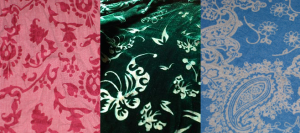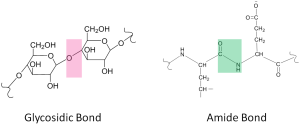With the season finale of Downton Abbey earlier this month, I know everyone is thinking, “Now, how will I get my fix of period costuming”? If you’re like me, you can scroll through hundreds of images online (when not in lab, of course), admiring all the textile embellishments of an era. One embellishment technique that rose to prominence in England during the 1920s is called devoré.

Devoré is an artistic adaption of the process used to remove plant based contaminants from wool. When contaminated wool is soaked in a weak acid and heated, the plant based fibers (composed mostly of cellulose) are burned away, leaving behind the wool (composed of protein based fibers such as keratin). This is because the glycosidic bonds in cellulose are easier to hydrolyze than the amide bonds in wool.

Similarly, devoré uses mixed fabrics composed of plant based fibers, such as cotton, and synthetic or protein based fibers, such as polyester or silk. The acid is then applied to the fabric in a design, and the plant based fibers, where the acid is applied, are burned away. The remaining synthetic or protein based fabric often provides a sheer effect. Aptly, devoré translates in French as ‘devoured’, as this technique eats away fabric to create aesthetic appeal.
Peer edited by Sumiyah Enayet